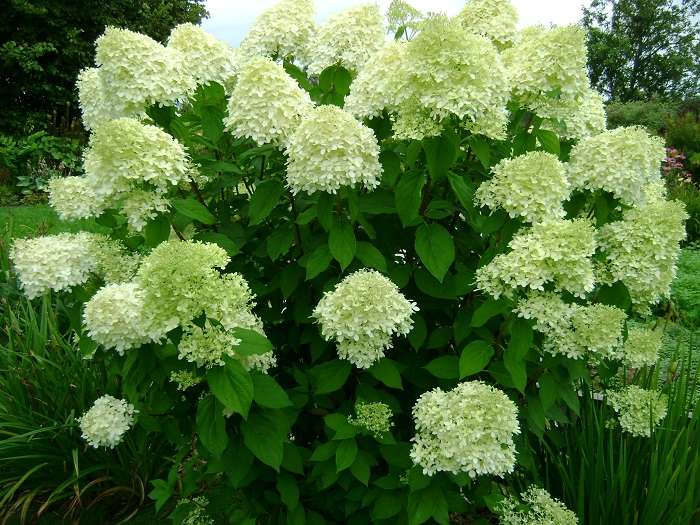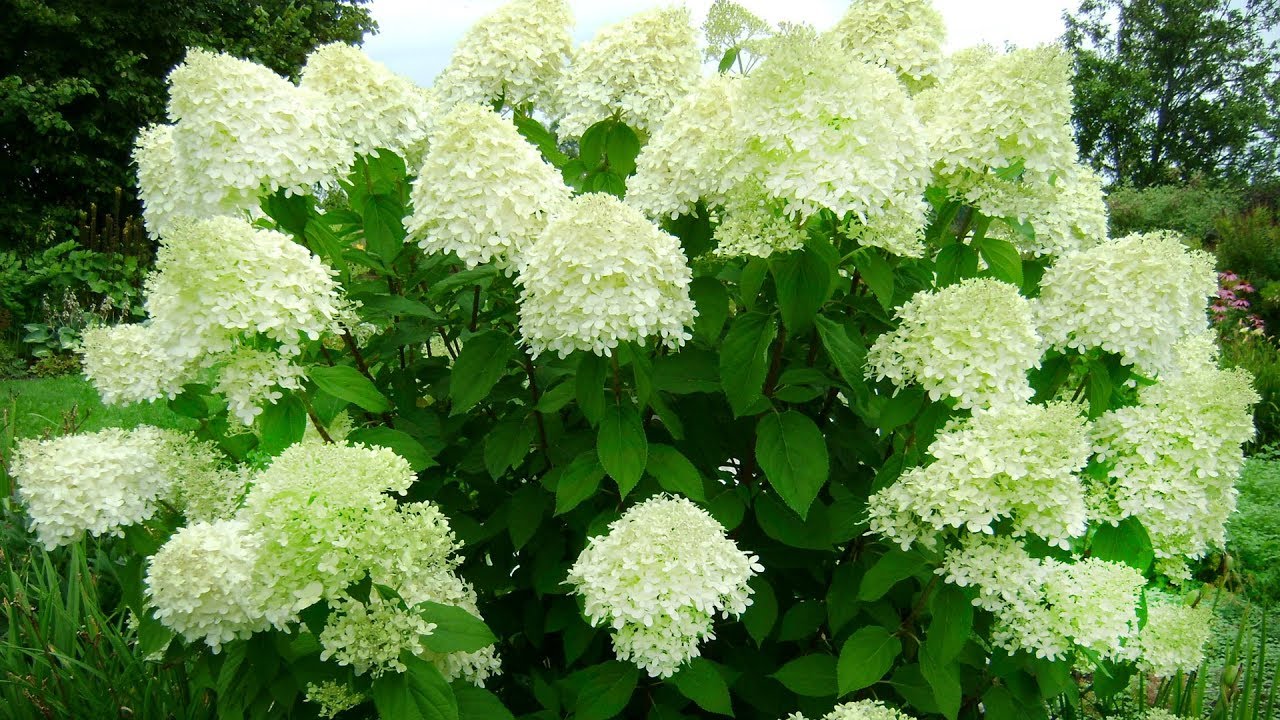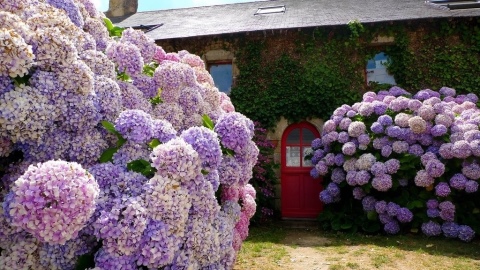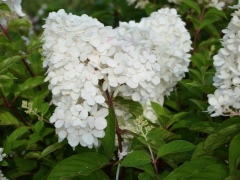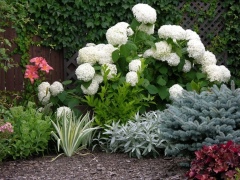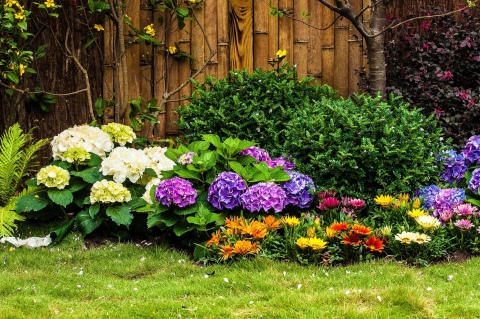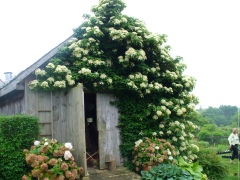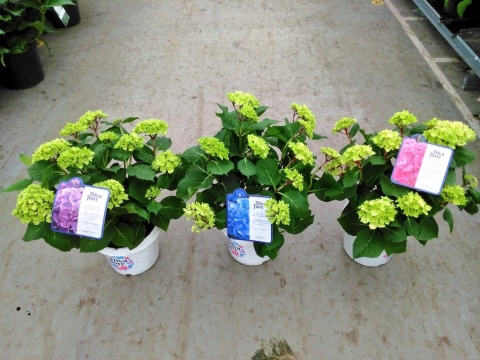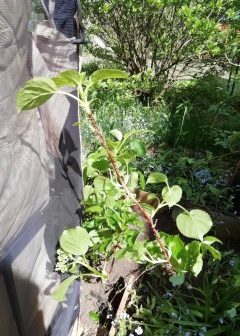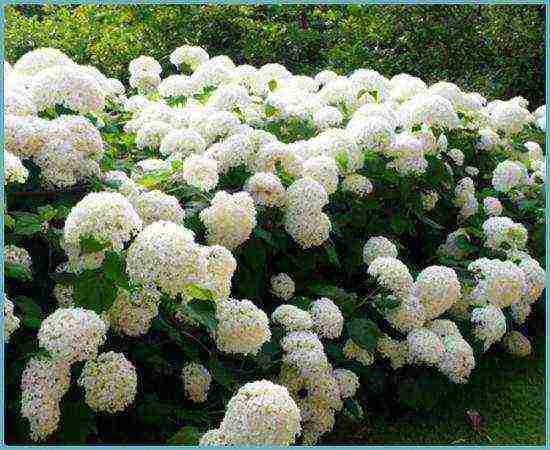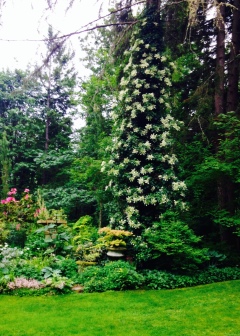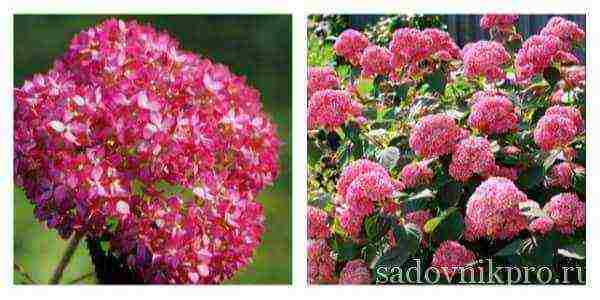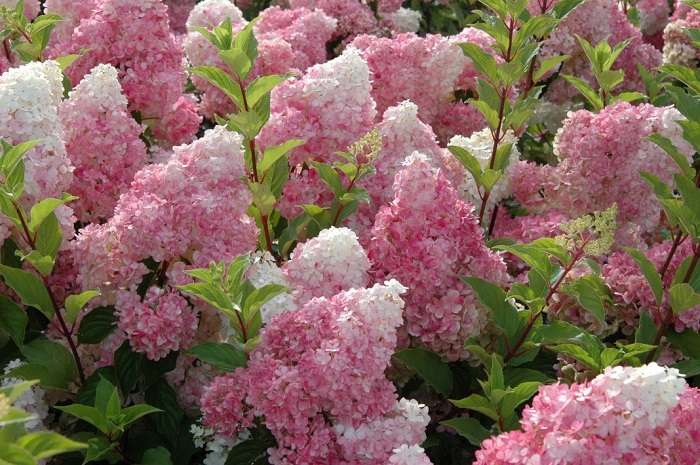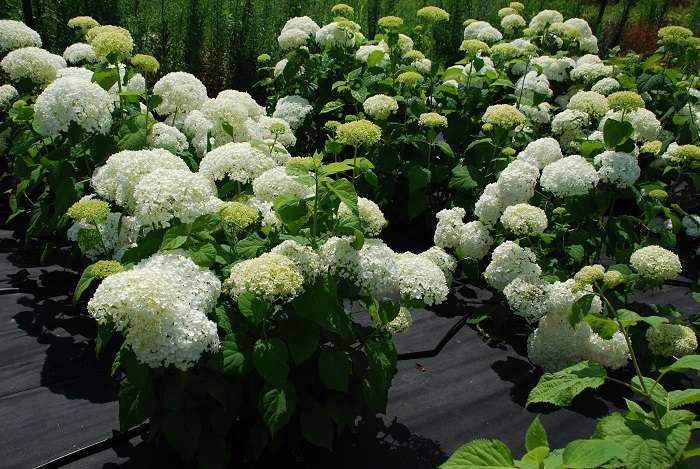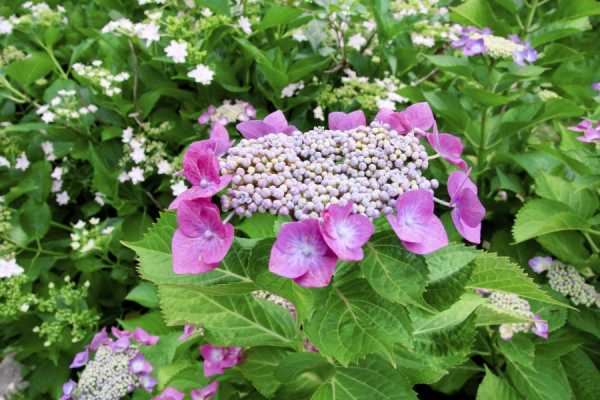Taking care of hydrangea
The process of growing and caring for this crop is simple, because the shrub is unpretentious, does not require any special time and physical costs. The main thing is to provide the plant with the basic conditions: watering, fertilizing, pruning, loosening, protection from pests and winter cold.
Watering
As it is clear from the Latin name of the flower ("vessel with water"), watering is the basis of all hydrangea care. You should focus on the weather: on dry and hot days, the bush is supplied with water 2 times a week (30 l: 1 m2), on rainy days - less often. Periodically add a small amount of manganese to the water, this will have a beneficial effect on the condition of the roots. The water should not be cold (20-25ºC). If a hydrogel is added to the soil during planting, it will prevent the soil from drying out.

Watering every 7 days
Mulching and loosening
Loosening the soil next to the bushes gives additional oxygen to the roots. Also, in the process, you can get rid of unnecessary grass and weeds. The main thing is not to overdo it: do not loosen the soil too deep (no more than 6 cm). Mulching will help to retain moisture and reduce the number of loosening procedures: provided that the mulch layer (5 cm) is constantly renewed, the substrate will have to be loosened only 3-4 times during the growing season.
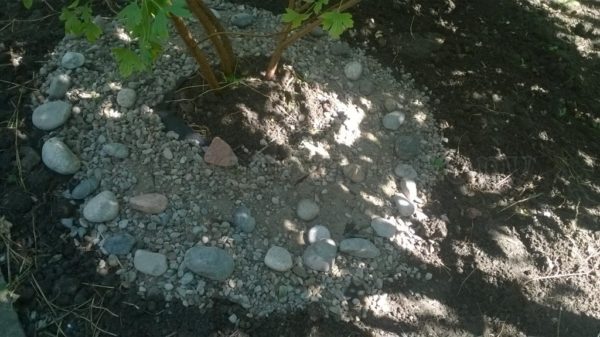
To prevent the trunk of the bush from crumbling and rotting from excess moisture, do not let the mulch layer come into contact with it.
Fertilizers and feeding
Fertilizing a hydrangea is essential if you want to enjoy its lush bloom.
Table 2. Fertilization scheme
| Top dressing | Fertilization time | Fertilizer composition |
|---|---|---|
| 1st feeding | Spring (beginning of sap flow) | Mullein, bird droppings |
| 2nd feeding | Mid spring (budding) | Potassium sulfate + superphosphate + urea + water (35: 40: 25: 10) |
| 3rd feeding | Midsummer (July) | Dung, "Kemira flower" |
| 4th feeding | End of the growing season (October) | Special fertilizer for hydrangeas (no nitrogen in the composition) |
| Regular feeding | With a frequency of 1 time in 14 days | Bird droppings diluted in water (1 in 10 l), or urea + superphosphate (10:20 g) |
Diseases and pests
Hydrangea paniculata, although it is considered resistant to all sorts of diseases, but, like any plant, it can be influenced by insects and diseases. In the absence of proper care, the bush may experience the following problems:
- Powdery mildew. It appears as a white bloom on the leaves. Means to combat it: Bordeaux liquid (1%), "Fundazol" (25 g: 10 l). Processing in 12-14 days.
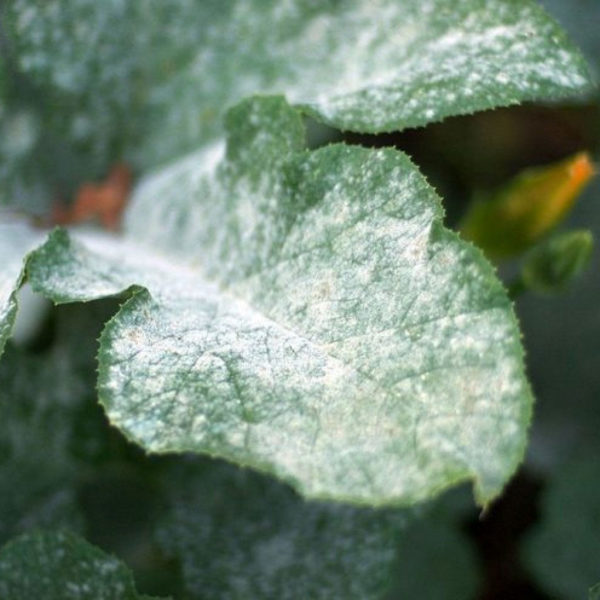
Powdery mildew
- Aphid. It is a very unpleasant phenomenon, which can be dealt with by special means (Aktellik, Akarin, etc.). You can prepare a solution of garlic (250 g), infused for 2 days in water (1 bucket). Add to it and dissolve 50 g of laundry soap, and process the leaves from the lower and upper sides. It is carried out 1 time in 7 days until the bush is completely cured.
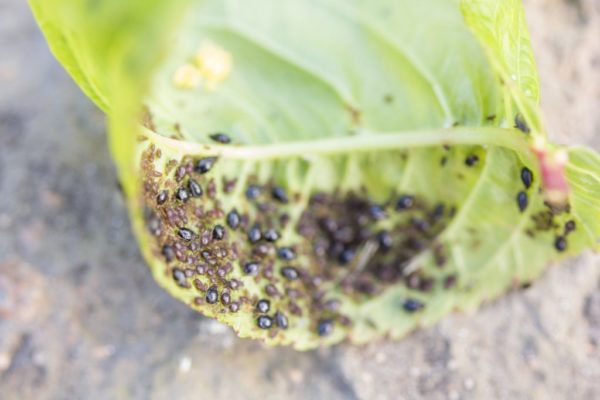
Aphid
- Chlorosis (disturbed plant metabolism). To get rid of the disease, the bush is regularly sprayed with Agricol, Chelat, Ferovit, Brexil and other drugs.
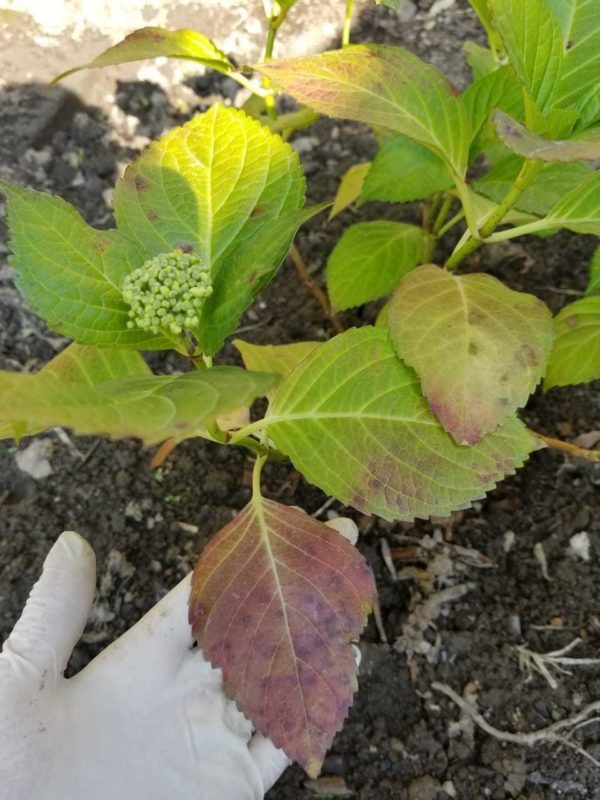
Chlorosis
- Ring spot. This is a virus, it infects the plant, killing it slowly. It manifests itself as spots on the leaves of a necrotic nature, followed by their withering away. It is impossible to cure a bush infected with ring spot, it will have to be completely removed from the ground and burned.

Ring spot
- Spider mite. It is fought with insecticides.

Spider mite
Pruning
It is best to cut the hydrangea in the spring, when the buds have already appeared, but have not yet blossomed
Incorrect cutting of a shrub can damage it, so it is very important to know the basic rules for pruning:
- shoots left from last year are removed by 1/3 part;
- weak and dry branches are completely cut off (at the root);
- adult bushes (5-6 years old) are pruned for rejuvenation up to 7-8 cm from the ground.
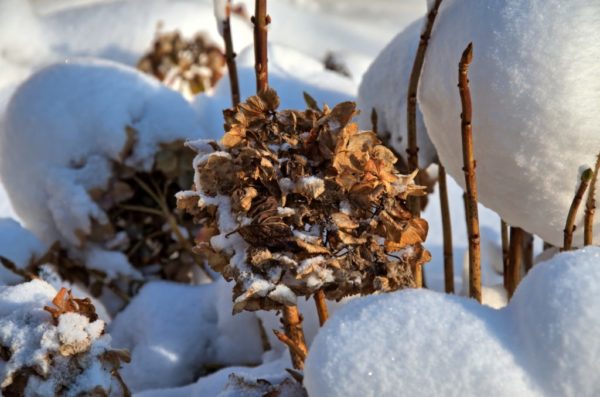
Dry inflorescences are not removed for the winter (they will warm new buds)
Winter shelter
Panicle hydrangea is a frost-resistant shrub. However, it also needs to be protected from the cold in winter. In particular, the root system should be protected, since the shoots themselves will recover in the spring. Shelters are used to protect against frost. To cover a bush, you need:
tie twigs and bend them to the ground;

Bend the branches to the soil
put straw on top and cover with material or spruce branches;

Cover the bush
fix the shelter with bricks or stones.

Secure the covering material
The bush can only be opened in the spring, at the end of the frost period.
Other popular varieties
Darts little dot darlido
Darts little dot darlido
Big ben
Big ben
Brussels lace
Brussels lace
Bulk
Bulk
Dharuma
Dharuma
Dvppinky
Dvppinky
Everest
Everest
Floribunda
Floribunda
Ilvobo
Ilvobo
Mega pearl
Mega pearl
October Bride
October Bride
Papillon
Papillon
Renhy
Renhy
Tender rose
Tender rose
White goliath
White goliath
White lady
White lady
‘White Lady’ (White lady, White lady, White Lady) - attractive serrated, sterile flowers. Semi-open panicles.
‘White Goliath’ (White Goliath, White Goliath, White Goliath) - medium, erect plant 170-170 cm with narrow open panicles, inflorescences become pale pink with age.
‘Renhy’ VANILLE-FRAISE (Vanilla Freyz Rennie, Vanilla Freyz) is a low, spreading bush. 125 × 185 cm. Red stem, inflorescences can bend to the ground due to weak stems, strong pruning will help. Proved to be less weatherproof than others, resulting in early browning of beautiful pink mature sterile flowers.
Tender Rose (Tender Rose, Tender Rose) - initially shows a good contrast between pink fertile flowers and sterile white, eventually becoming an unremarkable pale pink color. Cropping has no noticeable effect.
'Dvppinky' PINKY-WINKY - strong and compact habit 140 × 160 cm. Dark red stems and pink sterile inflorescences at maturity, deep pink. Reacts well to pruning, showing ideal pruning dependent flowering sequence. Suitable for small gardens. Blooms July-October.
Pink Lady (Pink Lady, Pink Lady) - with a characteristic, attractive pink blush developing along the edge of the sterile creamy inflorescence. Semi-open dense panicle, beautiful wide leaf. Tough pruning stimulates the growth of larger buds.
Pee Wee is a unique and compact form of the Grandiflora hydrangea. Pruning resulted in large differences between the three plants; the first heavily pruned was rather inconspicuous, the second was pruned less, gave many new shoots, the third uncircumcised plant was the best. However, dense panicles on a heavily pruned plant lodge.
Papillon (Papillon, Butterfly) - loose habit 160 × 210 cm. "Papillon", the French word for "butterfly", describes the shape of sterile flowers.
October Bride (Oktober Bride, October Bride) - erect shoots, spread slightly. Blooms until the first frost.
Mega Pearl (Mega Pearl) - blooms with pearl sterile flowers (July-October).
Floribunda (Floribunda) - elegant, pointed panicles (July-September), cream flowers turn pink with age. Pruning is required so that the bush does not grow too large. 190 × 210 cm.
‘Ilvobo’ BOBO (BoBo) is a compact and dwarf shrub (90 × 120 cm) with large, rounded or conical, white flower heads, in autumn they turn pink. Inflorescences cover every centimeter of the plant right down to the ground.
Big Ben (Big Ben) - has a half-open panicle. Standing out red stems. Sterile flowers turn pink quickly. Ideal for a large garden.
Brussels Lace (Brussels Lace, Brussels lace) - has distinctive small flowers and semi-open lace conical panicles, remains white at the end of the season (July-September), compact habit 120 × 160 cm.Various trimming options give little effect.
Dart's Little Dot ‘Darlido’ (Darlido Dart’s Little Dot) - the lowest variety (45 × 105 cm) among dwarfs, an open panicle blooms for a long period, July-September. Holds inflorescences well, does not need pruning.
Dharuma (Daruma) - has attractive red stems, early flowering, half-open panicles, compact foliage. Dark pink sterile flowers (June-October). It develops more slowly than most, great for a small garden. It is better to leave the bush without pruning, it grows 1-1.5 m. 120 × 115 cm.
EARLY SENSATION ‘Bulk’ - has excellent foliage and red stems. Dense and semi-open, rounded panicles, similar to "Dharuma", turn dark pink over time. Suitable as a hedge. Blooms from June to October. 145 × 200 cm.
Everest - Has a half-open panicle (July-September), dirty pink when it fades. Improved by hard pruning, resulting in larger panicles. 160 × 190 cm. Variety resistant to low temperatures in USDA zone 4.
Landing
The subtleties of planting are associated with the competent choice of a place for hydrangea. It is necessary to place it on the site so that the plant is illuminated in the morning and evening. Then you can count on rapid growth and subsequent lush flowering. The best soil for a paniculate variety is loam with high acidity, but it is not recommended to dilute the soil with chalk or slaked lime - for this, use the top layer of earth from under coniferous species and sour, high-moor peat. The substrate for the root system is prepared from clay, sand and peat mixture, and pebbles, expanded clay or fine gravel are placed on the bottom of the hole.
The disembarkation algorithm is as follows:
- a hole with a size of 50x50 cm is being prepared;
- long shoots of the root are cut off, when they dry, they are immersed in a biostimulant solution for 24 hours or kept in a clay chatterbox;
- nutrient soil is poured into the hole with a slide and a plant is placed on top;
- gradually pouring in the earth, it is simultaneously compacted, and the root collar is placed on the surface;
- the planted bush is watered, and the space under it is 5 cm thick, covered with humus.
10 most popular winter-hardy varieties of panicle hydrangea for central Russia
polar bear
Lush bush 2 m high. The length of the inflorescence (ear) is 40-45 cm! This is the largest inflorescence of all types of panicle hydrangea. Flowering begins in the second decade of July with white-cream flowers and ends by mid-September with pale pink flowers.
This variety is good as the main accent of the site, so it is planted near the gazebos, the front entrance, in the center of the spacious plot.
Lime light
The height of the bushes is 1.2 1.5 m, the size of the peduncles is 25-30 cm. The inflorescences consist of large sterile flowers. The bush is very compact and elegant. Flowering begins in mid-July. Blooms with lemon yellow flowers, and ends with snow-white caps.
Very good in combination with shrubs and perennials with brown leaves and stems. Looks advantageous as a plant of the foreground against the background of maiden grapes and ivy.
Vanilla freise
2015 Garden Show Winner. The height of the bush is 1.5-1.7 m. Peduncles are 30 cm high. It belongs to early-flowering hydrangeas in the Moscow region, the first flowers appear in the last decade of June. The first days of flowering completely white inflorescences in the form of a cone, then pink shades appear below, extending almost to the entire cone.
By the end of flowering (end of September), only the top of the cone remains snow-white, fully justifying its name vanilla ice cream.
At the same time, inflorescences of a very different combination of white and pink colors are located on one bush: from flowers that have just entered the phase of a pink hue to flowers that have already completed their "strawberry" repainting. No one will remain indifferent when they see this splendor!
Silver dollar
The height of the bush is 2.0 - 2.5 m.Inflorescences that are snow-white at the beginning of flowering and pinkish in the middle of flowering become at the end of the season a "dollar" shade with a transition to snow-white at the base of the flower pyramid.
Kyushu
A very popular variety among European urban gardeners. Refers to early flowering species. Its peculiarity is a delicate delicate aroma. The height of the plants is 2.0 - 2.5 m. The variety is planted near or instead of a hedge, as it tolerates even strong air pollution.
The most shade-tolerant of the popular hydrangea varieties. In Europe, it is used to decorate city squares, squares, public parks.
Bobo
Bred recently, but has already won the hearts of many gardeners and landscape designers. Its main feature is compactness - the plant height is only 60-70 cm.
At the same time, it is covered all over with white peduncles with a pinkish tint, the length of which is 30 cm, i.e. almost half of the stem blooms!
It is no coincidence that it is also called the "flowerbed on the legs." Flowering from early July until the onset of cold weather. Owners of small gardens are especially fond of this variety.
Phantom
A very harmonious bush, for which landscape designers love it: the bush grows very quickly, its height and diameter is 2 m.It blooms in August, the end of flowering is mid-September, the height of the peduncles is 25-30 cm.
Conical inflorescences have flowers of a gradient color: snow-white in the center, lilac closer to the edges. The bush looks elegant and sophisticated.
Mega Mindy
A neat small bush, which is 1.2 - 1.5 m high. It blooms in July with white inflorescences, which after a few weeks turn into cherry-pink, and by the end of flowering (September) become bright red.
It belongs to a fast growing variety. Will definitely be the main accent of the garden.
Grandiflora
The height of the bush is 2.0-2.5 m. The height of the peduncles is 30-35 cm. The bush has a cupped shape with powerful shoots that do not fall apart under the weight of the inflorescences.
During the growing season, there are 2 waves of color change of large sterile flowers that form inflorescences: at the beginning of flowering, the flowers are white, then they acquire pinkish notes, and closer to autumn, greenish flowers appear.
Weems ed
The bush is up to 1.3 m high. It blooms with white flowers in early July, but in the middle of summer the flowers change color to bright red. The bush has a delicate sweet aroma and very beautiful carved leaves.
How to plant?
Hydrangea prefers well-lit areas with little shading, making direct sunlight diffuse. Too bright sun can negatively affect the appearance of the crown and even lead to the loss of its decorative effect. Like other varieties, panicle hydrangea loves slightly acidic, acidic and neutral soils, while the land should be fertile.
In clay soil, the plant feels better than in sand, where it develops and grows much more slowly, therefore, before planting, black soil, coniferous litter, peat, and wood chips are added to it. It is impossible to deoxidize the soil with such means as slaked lime, wood ash or dolomite flour - this will lead to problems with cultivation. To normalize the composition, colloidal sulfur, ammonium salts, citric and succinic acids are used in the form of a solution for irrigation.
Due to the increased need for moisture, the shrub should be planted away from fruit crops, which may lack water. The place for placing the plant must be protected from drafts and wind, therefore it is advisable to build a fence or place a hydrangea near the wall. In regions with cold climates, it is better to plant bushes on the south side, and in the south in partial shade.
It is customary to plant hydrangea in open ground in spring, in March, before bud formation. During the spring and summer period, the shrub manages to adapt to new conditions, which means that it will bloom much faster.Variety "Grandiflora" can be planted in autumn, from October to November: if you properly cover young bushes for the winter, they can take root.
The ideal age of a seedling is no more than 2-3 years. As a rule, planting material with a closed root system is in a container. Preliminary work on processing open roots involves soaking in a biostimulator, where a little potassium permanganate is added to prevent fungal and bacterial diseases. If the roots of the bush are too long, they can be shortened, and then immersed in a clay solution - such procedures are carried out 2 hours before placing in the ground.
The correct planting of the hydrangea Grandiflora is as follows:
- when digging a hole, you should focus on the size of the root system, usually its depth is up to 60 cm with a diameter of 50 cm;
- the roots of the shrub are capable of growing strongly in breadth, therefore, when planting several plants, an interval of 2.5 m is observed;
- the nutrient mixture should consist of peat, garden (sod) soil, sand and compost; the plant will feel comfortable if the composition is supplemented with a small amount of needles; phosphorus, potassium and nitrogen-containing additives can also be added to the planting pit, then a young plant can not be fertilized for 2 years;
- the substrate is poured into the planting hole and left for 10-15 days for the natural subsidence of the earth;
- the day before planting, it is necessary to water the hole abundantly, after which you can plant a hydrangea; it is placed in the center, the root processes are straightened and covered with soil, leaving the root collar above the surface;
- after that, you can lightly tamp the near-trunk zone and water the earth around the bush with settled water in the amount of 12 liters.
The best varieties of hydrangea for the Moscow region: photos with names and descriptions
Undersized paniculate
The type of hydrangea paniculata (Hydrangea paniculata) includes 3 best varieties that can be cultivated in the Moscow region:
- Bobo (N.R. Bobo). Refers to dwarf forms. The flowering period lasts a long time and is quite abundant. The color of the flower petals changes from white to pink. The small height of the bush allows you to grow this variety in containers.
- Vanilla Fraise (N. p. Vanille Fraise). Suitable for growing in an open area, since during the growing season the height of the bush reaches 2 m. The diameter of the inflorescences ranges from 25-30 cm. The color of the petals can vary from lilac to crimson. The popularity is due to the fact that on one bush flowers can have several shades at the same time.
- Wim's Red. The inflorescences have a lush cone shape, up to 35 cm long. The bush attracts insects, which is due to the pleasant honey aroma that the flowers emit. The flowering period lasts from early summer until the first frost. The color of the petals gradually changes from white to pink, and then turns bright red.
The best varieties of panicle hydrangea in the photo with the names:
The varieties do not require careful self-care and take root well in the Moscow region.
Tree hydrangea
The type of tree hydrangea (Hydrangea arborescens) is the most common among gardeners in the Moscow region. The best varieties of hydrangea tree for the Moscow region:
- Annabelle (N. a. Annabelle). It has a high index of resistance to frost, which makes it possible to grow this variety in the Moscow region. The height of the bush can reach 150 cm, and the diameter of the shrub ranges from 3-3.5 m. The decorativeness of the plant remains until the first frost. The flowering period lasts from mid-summer to the end of September. The diameter of the inflorescences can be up to 25-30 cm.
- Grandiflora (N. and. Grandiflorum). The height of the shrub is 2 m, and its diameter ranges from 2 to 3 m. The crown has the shape of a ball. The length of the dark green leaves reaches 16 cm. The inflorescence is white with a stern tint. The variety requires a lot of light and moisture, does not tolerate drought. Often the shrub is used as a hedge.
- White House (N. a. White Dome). The height of the plant ranges from 1-1.5 m. The crown is dome-shaped. The shrub is prized for its beautiful elastic and strong white-cream inflorescences. Inflorescences are formed on young pagons. The flowering period lasts until early October. The variety tolerates both direct sunlight and partial shade well.
The popularity of tree hydrangea varieties is due not only to their attractiveness, but also to their adaptability to the climatic conditions of the Moscow region.
Large-leaved
This species is also known as the macrophylla or garden hydrangea (Hydrangea macrophylla). The best large-leaved hydrangea varieties for the Moscow region:
- Endless Summer (N. m. Endless Summer). This variety is able to withstand frost up to 30 °. The middle part of the inflorescence is occupied by purple flowers, and along its edge are white-green flowers.
- Blooming Star (N. m. Bloom Star). The diameter of the inflorescence can be up to 19 cm. Provided that the shrub is grown on alkaline soils, the color of the inflorescences becomes blue-violet. In other cases, the inflorescences have a bright burgundy hue.
- Mirai (N. m. Mirai). The flowers are distinguished by a beautiful white-pink color, which gradually changes to light green.
This species became the ancestor for breeding a large number of varieties adapted for cultivation in the Moscow region.
Chereshkova
Stalked or climbing hydrangea (Hydrangea petiolaris) has a high resistance not only to severe frosts, but also to diseases. The best varieties of petiolate hydrangea for the Moscow region:
- Miranda (N. p. Miranda). The leaves of this variety have a beautiful green color with a glossy surface. Small flowers. Their size does not exceed 12 cm in diameter. The shrub looks like a liana, the height of which reaches 10 m. It grows in shaded places. Shades poorly.
- Cordifolia (N. p. Cordifolia). The shrub grows to a height of no more than 1.5 m. It is resistant to diseases, insect damage, as well as severe frosts (up to 30 °). The edges of the green leaves are serrated. The flowers are creamy. The flowering period begins in early summer and lasts about 30 days.
The properties of varieties of this species make it possible to cultivate them in the Moscow region.
Planting large-leaved hydrangeas
Macrophyll planting requires great care and careful preparation.
The main attention should be paid to the preparation of the site and the soil mixture with which the planting pit will be filled.
The optimal planting time in regions with severe winters (including in the middle lane) is spring. Planting hydrangeas is carried out as soon as the weather permits, the soil will not only thaw, but also warm up, and the threat of severe frosts will pass.
For large-leaved hydrangea, the recommended planting distance is about 1 m.
Hydrangea is not simply covered with soil removed during the digging of a hole, but a special soil mixture is prepared in which the roots adapt and germinate faster. Peat, humus, coniferous soil are added to the garden soil in equal shares, preparing a loose and super nutritious soil mixture.
The garden soil removed from the hole, in turn, can be replaced with a mixture in equal proportions of sod, leafy soil and sand. But the key point is to determine the acidity of the soil, which, in turn, will provide the color of the inflorescences. If you want to grow those very blue, blue or purple hydrangeas (you can get them only from varieties with a pink or red color, but not from white-flowered hydrangeas), then you need to prepare in advance such a soil that will provide the original high acidity.
For blue colored hydrangeas, the pH should be between 5.0 and 5.5. For hydrangeas with white, pink and red inflorescences, the permissible value is from 6.0 to 6.2 (in acidic soil, the color of non-white varieties will change to lilac or blue).
In any case, large-leaved hydrangeas should not be planted in soil with a calcareous reaction (maximum allowable pH value is 6.4). If you want to get blue or lilac colors, then you need to add aluminum sulfate to the soil. At the same time, if the soil is changed specifically to obtain blue hydrangeas, it must be remembered that such an addition is only the first step. In the future, it will be possible to save the colors only with proper watering and fertilization. In addition to the acidifying additive, a full portion of complex mineral fertilizers is also applied to the soil.Today, the addition of hydrogel has become fashionable, which allows you to more effectively retain moisture.
The size of the planting pit should correspond to the size of the root ball of a large-leaved hydrangea: about 35 cm deep and wide for small bushes in small containers and half-meter holes for larger specimens. Preparing the landing pit will also require additional tweaks. To avoid the risk of water stagnation even on ordinary clay soils, improve water and air permeability, create an optimal environment at the bottom of the planting pits, you need to lay a drainage layer (expanded clay or pebbles, but not crushed stone).
Before planting, the upper free layer of the substrate is carefully removed from the container (usually it is quite dirty), and the plant is watered abundantly for at least a few hours. When taking out a hydrangea, you need to be very careful and try not to destroy the earthen lump. In a cramped container or pot, strong young roots tend to curl around the perimeter of the earthen coma, as if entangling the substrate. They need to be straightened, straightened carefully, without injuring the small roots.
A thin layer of soil is poured at the bottom of the hole and a small mound is created. A hydrangea is placed on it, straightening long roots. Then the seedling is carefully covered with the prepared soil mixture, carefully tamping the soil and gently compacting it around the root ball. When planting, you need to ensure that the depth of the root collar does not change.
Planting large-leaved hydrangea is completed with abundant watering and mulching: the trunk circle is covered with a layer of peat or a mixture of peat and compost with a height of 7 to 10 cm.
Planting large-leaved hydrangea
Planting and caring for shrubs outdoors
In order for the bushes to please the eye, have an attractive and healthy appearance over the years, it is necessary to observe some important conditions for planting and care in the open field.
For planting plants, it is recommended to choose a shaded place, protected from direct sunlight and winds. Hydrangeas do not respond well to shade and drought. If planted in an open, sunny area, the flowering period will pass several times faster, and the inflorescence colors will not be saturated and bright.
It is not recommended to plant bushes closer than 2-2.5 m from other plantings. This is due to the fact that the plant has a well-developed horse system. If she does not have enough space, the bush will grow slowly, and the flowering will not be saturated.
Since plants have a rather well-developed bark system, a large pit must be prepared for planting (1.0 mx 1.5 m). Bushes react to the quality of the soil. To improve it, it is recommended to add peat, sand, humus and forest litter to the ground when planting. It will also not be superfluous to add fertilizers such as Tiovit Jet or Ferovit to the soil mixture. After planting, the plant is watered abundantly, and the soil surface near it is mulched.
For watering shrubs, it is better to use settled water or rainwater. You can add 30-40 grams of table vinegar (per 10 liters) or 3-4 grams of citric acid to it. You can ensure the brightness of the color of the inflorescences by adding aluminum alum to the water for irrigation (1 tablespoon per bucket). Watering frequency depends on weather conditions. In the Moscow region, it reaches 2 times a week.
It is recommended to pour at least 1 bucket of water under each adult bush. In order to retain moisture in the ground and prevent the soil clod from drying out, experienced gardeners recommend mulching the ground around the shrub. To do this, you can use peat, spruce branches, dry grass or foliage.
In order for the plant to have a healthy look and bloom beautifully, the bush needs to be fed with fertilizers, which include trace elements. You need to fertilize the bushes no more than 1 time for 30 days.
Do not forget about such a procedure as loosening the soil. This is especially true if the flower is grown on dense soils.The loosening depth must be at least 15 cm.
Despite the fact that hydrangeas are frost-resistant plants, they still need simple preparation for wintering. In the middle of autumn, dried inflorescences and all leaves are removed from the shrub.
You cannot cut off shoots. This will lead to the fact that the next year the plant will not bloom.
After that, the branches of the bush are collected in a bunch and tied with ropes. The bush is gently bent to the soil surface and secured with metal braces. Some gardeners practice using spruce branches or dry leaves to shelter hydrangeas for the winter. After the snow melts, the shelter can be removed, and the branches of the bush can be freed from the ropes.
Video on what to do if hydrangea is frozen:
During the period of a long rainy season, the possibility of the development of such a disease as gray rot is not excluded. In this case, the leaf blades are covered with gray spots, after a while they fall off. The disease can also affect inflorescences. To combat gray rot, it is necessary to immediately remove the affected leaves and inflorescences, and treat the remaining leaf blades and shoots with a Bordeaux mixture or Fundazol.
Treating a shrub with a Bordeaux mixture will also help get rid of an ailment such as septoria.
The most dangerous insects are ticks and aphids. If they are found on leaves or inflorescences, the bush should be immediately sprayed with water with thiophos or anabazine sulfate added to it.
Observing simple recommendations, in the Moscow region you can grow beautiful bushes that will delight everyone with their long flowering.
Video about the agricultural technology of growing hydrangeas in the Moscow region:
Hydrangea paniculata sundae fraise
Over the past ten years, many varieties of panicle hydrangea have been bred. The compact forms of the well-known ornamental shrub also saw the light of day. A real innovation in this sense is, for example, the Sunday Fries variety.
Description of appearance and features
Sunday Fries is a miniature variety. Its maximum height is 120 cm and its width is 1 meter. This is a slightly sprawling shrub, so the plant does not hold its shape very well. At the same time, the crown is dense.
On red-brown stems there are elongated ovoid or oblong dark green leaves, up to 12 cm in length, covered with pile from the outside and inside, most of all - in the zone of veins.
The shoots of the culture are not very strong and often droop during flowering.
In the first half of summer, large pyramidal inflorescences are formed on hydrangeas. They consist of small flowers: sterile, reaching 2.5 cm in diameter, and smaller fertile ones, with early falling petals.
The initial color of the inflorescences is white, but gradually it is replaced by a pink tint, and by autumn the flower "candles" become crimson. The combination of shape and rich colors makes the inflorescences of this variety look like a berry ice cream in a glass. For this reason, among gardeners, the shrub is often called "strawberry ice cream".
Sunday fries are frost-resistant. She absolutely does not care about lowering the air temperature to -25 ° C. The flower feels good in conditions of increased pollution and gas pollution of the surrounding atmosphere.
Agrotechnical features
Sundae fraise does not make high demands on cultivation and care. Hydrangea should be placed in a bright area if you live inmiddle zone of Russia or in the northern region of the country, and in partial shade when in a zone with a southern climate. Make sure that the summer midday sun does not harm your beauty. Protect the flower from cold drafts.
The French diva prefers moist, highly fertile soils with an acidic reaction (optimal substrate pH values are 4-6.5). By the way, the more acidic the soil in which you plant the Sunday Frize is, the more intense the shade of the inflorescences on the plant will be.
Stick to the following potting mix: 2 parts leafy soil, 2 parts humus, 1 part sand, and the same amount of peat. Dig a planting hole 30 cm deep and wide. Lay a good drainage layer on its bottom, then fill in the soil. When planting, let the root collar of the plant remain above the soil surface.
The acidity level of the substrate can be increased by enriching the soil with ammonium sulfate, ferrous sulfate or potassium sulfate. An alternative to this method is the introduction of organic acids - for example, acetic or citric - into the water for irrigating a flower in a proportion of 10 grams of substance per 1 liter of liquid.
For irrigation, use settled water, slightly warmed up in the sun. About 10 liters of water is poured under the Sunday fries bush.
Periodically loosen the soil and mulch it with pine needles, peat or sawdust so that moisture remains in the ground longer. Weeding regularly is a good way to reduce crop water losses.
The plant needs feeding. They should be carried out no more than once every 2 weeks. The shrub is susceptible to the alternation of organic matter and mineral complexes. As the first, slurry and water infusion of bird droppings are used. The best mineral concentrates for culture are potassium nitrate and superphosphate.
The Sunday Fries are shown for the spring and fall skins. In April, the crop is removed from diseased, dry and damaged shoots, and stems that are too long are shortened in order to form a bush. In the fall, sanitary pruning is performed and dried inflorescences are removed.
Despite the winter hardiness, the bush spuds with the onset of cold weather. The height of the embankment you create should be between 20 and 30 cm.
To preserve last year's shoots of hydrangea, which will give lush inflorescences in spring, you should bend them to the ground, cover the Sunday fries bush with fallen leaves on top and cover with a wooden box.
The plant is threatened by some diseases. We are talking about chlorosis, gray rot, downy mildew. Sundae fraise is also capable of attacking insect pests: aphids, spider mites, golden bronze, leafworm caterpillar, furry deer and others.
Your plant will be reliably insured against the development of chlorosis if you take care of the absence of excess lime in the soil under it.







